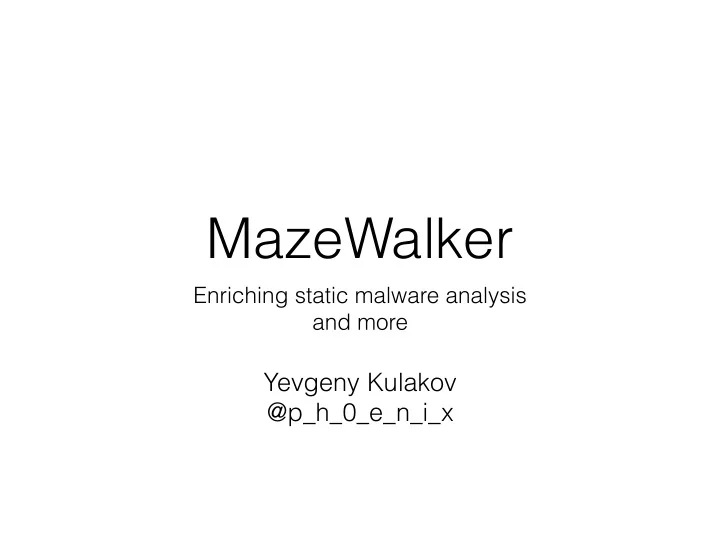

MazeWalker Enriching static malware analysis and more Yevgeny Kulakov @p_h_0_e_n_i_x
About Me • Malware RE @ Trusteer, IBM, Seculert • binary analysis automation • sandbox development • Now in vEYE Security on software container problems
Agenda • Malware vs Reverser • General idea behind MazeWalker Tool • How and What MazeWalker solves • Demo • Future work
Malware vs Reverser Prevent or slowdown manual analysis Make me suffer
Some examples of annoying behaviour
Code (un)packing • New executable areas introduced • Runtime code change • Stack-based execution Sample Layer 1 Layer 1 Payload Layer 0 Decrypt code Resolve + Unpack
Code (un)packing - PiC • Runtime CF change - Indirect Calls & Jumps
Environment Detection • Anti-VMs • API based • device enumeration • api monitoring detection (cuckoobox hooks) • ASM based • elapsed time diff
Code dispersion • Hard to follow - several debug sessions • Attaching debugger may freeze the UI svchost.exe watchdog Sample explorer.exe operational CnC, rootkit deployment Kernel Permission Elevation
Obfuscate at rest • Encrypt all the things - cfg, code, etc • Obfuscate API calling or resolve it on each API call • Own API resolution - use own DLLs copies • Abuse asm and mix code with data
No Run No Fun
A word on code amount
There is a lot of code • Malware is taken as a serious software project • release cycles, test labs, dev teams • copy & paste from other malware projects too
Carberp
Gozi
There is a lot of code (cont) • Culminates in large codebase over time • Takes substantial amount of time to analyze
Time is Money both are at most insufficient
Ideas behind MazeWalker
MazeWalker - Main Ideas • It must save time !!!! • Maximize time spent in IDA vs time in Debugger • Work with non modified VMs • Retrieve all runtime info and push into IDA • Help with overall malware understanding • dig into asm on an interest - basis • enable research focusing
PinTool IDA Plugin Python Engine MazeWalker Tool Memory Track Code Analysis Architecture
Pin is a dynamic binary instrumentation framework for the IA-32, x86-64 and MIC instruction-set architectures that enables the creation of dynamic program analysis tools. Intel’s Pin Framework • Callbacks on everything • instructions • VM in essence • API calls • Image loading • Multi-platform • Threads, Exceptions • memory read/writes
Code unpacking - memory • Rely on allocated page analysis • Tracks all executed memory by comparing executing BBL to older copy • detect new PEs • identify known (dynamically) loaded DLLs
Code unpacking - PiC • Pin helps to do Call/Jump site analysis • Logging call-site <-> target pair
System API monitoring • Pin’s Routine Objects • Harder to detect • Configurable + • API Agnostic monitor interface • Scriptable
System APIs - CreateFileW
Environment Detection
Code dispersion • Use scriptable APIs monitoring for code injection tracking • this helps Pin to find target process • Use Pin’s existing ability to track child processes
Code dispersion OpenProcess API
Control Flow Graph With PIN’s BBL callbacks Covers all memory regions Covers across different processes
Threads everywhere All execution metadata is on thread basis
Demo
Collected Data
Hierarchy matters Navigate the execution flow Original IDA Maze Walker
Hierarchy matters Wrapped functions get different meaning with context
Focus Work on Memory Part Only
Focus Focussing on Registry only
ToDo…
Further development • Stability and Memory consumption reduction • Memory dumps consolidation • Custom IDA Loader • “Maze Walk” in kernel space • Implement anti-instrumentation prevention logic Dynamic Binary Instrumentation Frameworks: I know you're there spying on me (ReCon 2012) •
https://github.com/0xPhoeniX/MazeWalker.git
Thank you! @p_h_0_e_n_i_x
Recommend
More recommend